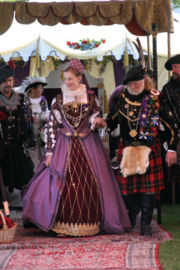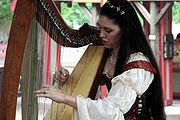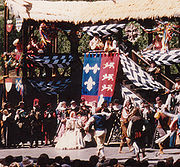
Renaissance Fair
Encyclopedia

Elizabeth I of England
Elizabeth I was queen regnant of England and Ireland from 17 November 1558 until her death. Sometimes called The Virgin Queen, Gloriana, or Good Queen Bess, Elizabeth was the fifth and last monarch of the Tudor dynasty...
. Some are set earlier, during the reign of Henry VIII
Henry VIII of England
Henry VIII was King of England from 21 April 1509 until his death. He was Lord, and later King, of Ireland, as well as continuing the nominal claim by the English monarchs to the Kingdom of France...
, or in other countries, such as France, and some include broader definitions of the Renaissance which include earlier periods, such as the Vikings, or later, such as 18th Century pirates, and some engage in deliberate "time travel" by encouraging participants to wear costumes representing several eras in a broad time period. Renaissance fairs encourage visitors to enter into the spirit of things with costumes and audience participation. Most tolerate, and many welcome, fantasy elements such as wizards
Magician (fantasy)
A magician, mage, sorcerer, sorceress, wizard, enchanter, enchantress, thaumaturge or a person known under one of many other possible terms is someone who uses or practices magic that derives from supernatural or occult sources...
and elves
Elf
An elf is a being of Germanic mythology. The elves were originally thought of as a race of divine beings endowed with magical powers, which they use both for the benefit and the injury of mankind...
.
Chicago journalist Neil Steinberg
Neil Steinberg
Neil Steinberg is an American news columnist for the Chicago Sun-Times. He joined the staff in 1987, and his column appears four times a week....
said (of the Bristol Renaissance Faire
Bristol Renaissance Faire
Bristol Renaissance Faire is a Renaissance fair held in the village of Bristol, Wisconsin, near Kenosha, Wisconsin, that recreates the visit of Queen Elizabeth I to the port city of Bristol in the year 1574. The Faire plays in a permanent park with most buildings permanent year-round structures,...
), "If theme parks
Amusement park
thumb|Cinderella Castle in [[Magic Kingdom]], [[Disney World]]Amusement and theme parks are terms for a group of entertainment attractions and rides and other events in a location for the enjoyment of large numbers of people...
, with their pasteboard main streets, reek of a bland, safe, homogenized, whitebread America, the Renaissance Faire is at the other end of the social spectrum, a whiff of the occult
Occult
The word occult comes from the Latin word occultus , referring to "knowledge of the hidden". In the medical sense it is used to refer to a structure or process that is hidden, e.g...
, a flash of danger and a hint of the erotic
Eroticism
Eroticism is generally understood to refer to a state of sexual arousal or anticipation of such – an insistent sexual impulse, desire, or pattern of thoughts, as well as a philosophical contemplation concerning the aesthetics of sexual desire, sensuality and romantic love...
. Here, they let you throw axes. Here are more beer and bosoms than you'll find in all of Disney World."
Characteristics


Elizabeth I of England
Elizabeth I was queen regnant of England and Ireland from 17 November 1558 until her death. Sometimes called The Virgin Queen, Gloriana, or Good Queen Bess, Elizabeth was the fifth and last monarch of the Tudor dynasty...
, as this period has been generally considered to correspond to the flowering of the English Renaissance
English Renaissance
The English Renaissance was a cultural and artistic movement in England dating from the late 15th and early 16th centuries to the early 17th century. It is associated with the pan-European Renaissance that is usually regarded as beginning in Italy in the late 14th century; like most of northern...
.
In a modern Renaissance festival there are stages or performance areas set up for scheduled shows, such as plays in Shakespearean
William Shakespeare
William Shakespeare was an English poet and playwright, widely regarded as the greatest writer in the English language and the world's pre-eminent dramatist. He is often called England's national poet and the "Bard of Avon"...
or commedia dell'arte
Commedia dell'arte
Commedia dell'arte is a form of theatre characterized by masked "types" which began in Italy in the 16th century, and was responsible for the advent of the actress and improvised performances based on sketches or scenarios. The closest translation of the name is "comedy of craft"; it is shortened...
tradition, as well as anachronistic
Anachronism
An anachronism—from the Greek ανά and χρόνος — is an inconsistency in some chronological arrangement, especially a chronological misplacing of persons, events, objects, or customs in regard to each other...
audience participation comedy routines. Other performances include dancers, magicians, musicians, jugglers, and singers. Between the stages the streets ('lanes') are lined with stores ('shoppes') and stalls where independent vendors sell medieval and Renaissance themed handcrafts, clothing, books, and artworks. There are food and beverage vendors, as well as game and ride areas. Games include basic skills events such as archery or axe-throwing as well as Drench-a-Wench and Soak-a-Bloke
Dunk tank
A dunk tank, also known as a dunking booth or dunking machine, is an attraction mainly used in funfairs, fundraisers, and personal parties. Basically, a dunk tank consists of a large tank of water, over which a seat is suspended...
, which allow a player with a good aim to hit a target and get a fair employee wet. Rides are typically unpowered—various animal rides and human-powered swings are common. Live animal displays and falconry
Falconry
Falconry is "the taking of wild quarry in its natural state and habitat by means of a trained raptor". There are two traditional terms used to describe a person involved in falconry: a falconer flies a falcon; an austringer flies a hawk or an eagle...
exhibitions are also commonplace. Larger Renaissance fairs will often include a joust
Jousting
Jousting is a martial game or hastilude between two knights mounted on horses and using lances, often as part of a tournament.Jousting emerged in the High Middle Ages based on the military use of the lance by heavy cavalry. The first camels tournament was staged in 1066, but jousting itself did not...
as a main attraction.
In addition to the staged performances, a major attraction of Renaissance fairs is the crowds of actors - both professional and amateur - who play all sorts of historical figures and roam the fair, interacting with visitors. Visitors are encouraged to wear costumes, once any weapons are suitably peace-bonded, contributing to the illusion of an actual Renaissance environment. Many of the fair vendors sell or rent costumes for all ages and types. The Renaissance fair subculture's word for these costumed guests is "playtrons", a portmanteau of the words "patron" and "player", and they add a second level of enjoyment to their experience by "getting into the act" as Renaissance Lords and ladies, peasants, pirates, belly dancers, or fantasy characters. However, many renaissance fairs discourage interaction between the official cast and so-called "playtrons."
Most fairs have an end-of-the-day ritual, a parade or concert where all employees gather and bid farewell to the patrons.
Renaissance fairs are staged around the United States at different times of the year. Fair vendors, participants and crew often work the "faire circuit", going from event to event as one fair ends and another begins.
History of the fairs in America

Early Music Revival
See Early music and Historically informed performance for a more detailed explanation of this topic.The general discussion of how to perform music from ancient or earlier times did not become an important subject of interest until the 19th century, when Europeans began looking to ancient culture...
, and out of that came folk musician and traditionalist John Langstaff
John Langstaff
John Langstaff , a concert baritone, and early music revivalist was the founder of the Northeast United States tradition of the Christmas Revels, as well as a respected musician and educator. He attended the Curtis Institute of Music as well as Juilliard. In 1943 he married Diane Hamilton...
. In 1957, Langstaff held "A Christmas Masque of Traditional Revels" in New York City, and the following year another in Washington, D.C.
Washington, D.C.
Washington, D.C., formally the District of Columbia and commonly referred to as Washington, "the District", or simply D.C., is the capital of the United States. On July 16, 1790, the United States Congress approved the creation of a permanent national capital as permitted by the U.S. Constitution....
. A televised version was broadcast on the "Hallmark Hall of Fame
Hallmark Hall of Fame
Hallmark Hall of Fame is an anthology program on American television, sponsored by Hallmark Cards, a Kansas City based greeting card company. The second longest-running television program in the history of television, it has a historically long run, beginning in 1951 and continuing into 2011...
" in 1966 which included Dustin Hoffman
Dustin Hoffman
Dustin Lee Hoffman is an American actor with a career in film, television, and theatre since 1960. He has been known for his versatile portrayals of antiheroes and vulnerable characters....
playing the part of the dragon slain by Saint George
Saint George
Saint George was, according to tradition, a Roman soldier from Syria Palaestina and a priest in the Guard of Diocletian, who is venerated as a Christian martyr. In hagiography Saint George is one of the most venerated saints in the Catholic , Anglican, Eastern Orthodox, and the Oriental Orthodox...
, and in 1971 Langstaff established a permanent Christmas Revels
Revels
Revels is a contemporary series of American seasonal stage performances, initially given at Christmas time as the Christmas Revels at Town Hall in New York City in 1957, which involve singing, dancing, recitals, theatrics , and usually some audience participation, all appropriate to the season...
in Cambridge, Massachusetts
Cambridge, Massachusetts
Cambridge is a city in Middlesex County, Massachusetts, United States, in the Greater Boston area. It was named in honor of the University of Cambridge in England, an important center of the Puritan theology embraced by the town's founders. Cambridge is home to two of the world's most prominent...
.
In 1963, Los Angeles schoolteacher Phyllis Patterson held a very small Renaissance fair as a class activity, in the backyard of her Laurel Canyon home in the Hollywood Hills. On May 11 and 12 of that year, Phyllis and her husband Ron Patterson, presented the first "Renaissance Pleasure Faire" as a one-weekend fundraiser for radio station KPFK
KPFK
KPFK is a listener-sponsored radio station based in North Hollywood, California, United States, which serves the Greater Los Angeles Area, and also streams 24 hours a day via the Internet...
, drawing some 8,000 people.
The fair was designed by the Living History Center to resemble an actual spring market fair of the period. Many of the original booths were no-charge reenactments of historical activities including printing presses and blacksmiths. The first commercial vendors were mostly artisans and food merchants and were required to demonstrate historical accuracy or plausibility for their wares. Groups of volunteers were organized into "guilds" to focus on specific reenactment duties (musicians, military, celtic clans, peasants, etc). Both actors and vendors were required to successfully complete workshops in period language and accents, costuming, and culture, and to stay "in character" while working.
For many years thereafter, the Renaissance Pleasure Faire of Southern California
Renaissance Pleasure Faire of Southern California
The Renaissance Pleasure Faire of Southern California , is the first, original modern Renaissance Fair; it opened in 1962 and has run yearly since that time. Presently owned by Renaissance Entertainment Productions , it is a commercial re-enactment of a 1580s market faire at Port Deptford, an...
(RPFS) was held in the spring at the Paramount Ranch located in Agoura, California, partaking of the rich lore and age-old customs of English springtime markets and "Maying" customs. Five years later, the Pattersons created a fall Renaissance fair, with a harvest festival theme, first at what is now China Camp State Park in San Rafael, California and two years later at the Black Point Forest in Novato, California. Both fairs developed into local traditions and began a movement that spread across the country, though fairs that copied the original frequently did not attempt such historical accuracy.
An American phenomenon
Although historical reenactments are by no means exclusive to the United States (for example, the Earl of EglintonArchibald Montgomerie, 13th Earl of Eglinton
Sir Archibald William Montgomerie, 13th Earl of Eglinton KT, PC , known as Lord Montgomerie from 1814 to 1819, was a British Conservative politician...
in Scotland
Scotland
Scotland is a country that is part of the United Kingdom. Occupying the northern third of the island of Great Britain, it shares a border with England to the south and is bounded by the North Sea to the east, the Atlantic Ocean to the north and west, and the North Channel and Irish Sea to the...
sponsored a large tournament
Eglinton Tournament of 1839
The Eglinton Tournament of 1839 was a re-enactment of a medieval joust and revel held in Scotland on Friday 30 August.It was funded and organized by Archibald Montgomerie, 13th Earl of Eglinton, and took place at Eglinton Castle, near Kilwinning in Scotland...
in 1839), the Renaissance fair is, arguably, a uniquely American variation on the theme, having as much the flavor of an amusement park
Amusement park
thumb|Cinderella Castle in [[Magic Kingdom]], [[Disney World]]Amusement and theme parks are terms for a group of entertainment attractions and rides and other events in a location for the enjoyment of large numbers of people...
combined with a shopping mall as of a historical reenactment
Historical reenactment
Historical reenactment is an educational activity in which participants attempt torecreate some aspects of a historical event or period. This may be as narrow as a specific moment from a battle, such as the reenactment of Pickett's Charge at the Great Reunion of 1913, or as broad as an entire...
. European historical fairs, on the other hand, operate more on the living history museum
Open air museum
An open-air museum is a distinct type of museum exhibiting its collections out-of-doors. The first open-air museums were established in Scandinavia towards the end of the nineteenth century, and the concept soon spread throughout Europe and North America. Open-air museums are variously known as...
model, in which an actual historic site is peopled by reenactors whose job it is to explain historical life to modern visitors. Renaissance fair patrons in the United States may be as interested in drinking, eating, shopping, and watching farce
Farce
In theatre, a farce is a comedy which aims at entertaining the audience by means of unlikely, extravagant, and improbable situations, disguise and mistaken identity, verbal humour of varying degrees of sophistication, which may include word play, and a fast-paced plot whose speed usually increases,...
as they are in an educational experience.
In recent years, American-style Renaissance fairs have made inroads in other countries. Germany has seen a very similar phenomenon since the 1980s (see :de:Mittelaltermarkt), and beginning in the mid-1990s, Renaissance fairs have spread into Canada.
Spinoffs of Renaissance fairs also include fairs set in other time periods, such as Christmas
Christmas
Christmas or Christmas Day is an annual holiday generally celebrated on December 25 by billions of people around the world. It is a Christian feast that commemorates the birth of Jesus Christ, liturgically closing the Advent season and initiating the season of Christmastide, which lasts twelve days...
fairs set in Charles Dickens
Charles Dickens
Charles John Huffam Dickens was an English novelist, generally considered the greatest of the Victorian period. Dickens enjoyed a wider popularity and fame than had any previous author during his lifetime, and he remains popular, having been responsible for some of English literature's most iconic...
' London. The American approach has apparently been exported back to England; a warehouse-based theme park, "Dickens World", opened in Kent, England, in May 2007.
Names
Renaissance fairs have several variant names, many of which use old-fashioned spellings such as faire or fayre. These spellings originate from the Middle EnglishMiddle English
Middle English is the stage in the history of the English language during the High and Late Middle Ages, or roughly during the four centuries between the late 11th and the late 15th century....
feire (variant spellings include feyre, faire, and fayre), which comes from the Anglo-French word feire. They can also be referred to as "Elizabethan", "Medieval", or "Tudor" fairs or festivals. "Ren Fair" and "Ren Fest" are popular colloquialisms. A German Mittelaltermarkt (literally "medieval market") is very similar to a Renaissance fair.
Controversies
Within the Renaissance fair community, there is difference of opinion as to how authentic a fair ought to be. Some believe fairs should be as authentic an experience as possible, with educational aspects like European living history museums. Others believe that entertainment is the primary goal. Richard Shapiro, who founded what later became the Bristol Renaissance FaireBristol Renaissance Faire
Bristol Renaissance Faire is a Renaissance fair held in the village of Bristol, Wisconsin, near Kenosha, Wisconsin, that recreates the visit of Queen Elizabeth I to the port city of Bristol in the year 1574. The Faire plays in a permanent park with most buildings permanent year-round structures,...
, said he favors entertainment. "We were so authentic back then it was almost painful."
External links
- Mike Bonk's Directorie - index of over 200 operating renaissance festivals around the world.

